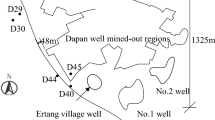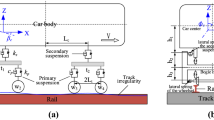Abstract
This study aimed to suggest a method for assessing the liquefaction-induced damage to railway embankments, one of the major national SOC infrastructures. To achieve that purpose, the railroad design and maintenance standards in South Korea were examined, and risk assessment method was proposed. The risk assessment of liquefaction-induced damage was classified into no damage level, caution level, and critical level based on the assessment of vertical irregularity, residual settlement, and lateral displacement. To assess the liquefaction-induced damage, three simplified assessment methods and a dynamic numerical analysis method with a finite difference method were proposed. Finally, these methods were applied to the roadbed of the Honam high-speed line, and its applicability was investigated. According to the results, the related standards showed the most overestimated value of settlement among the simplified assessment methods, and the dynamic numerical analysis technique showed the most underestimated value of settlement.
Similar content being viewed by others
References
Bray JD, Dashti S (2014) Liquefaction-induced building movements. Bulletin of Earthquake Engineering 12(3):1129–1156
Bray JD, Macedo J (2017) 6th Ishihara lecture: Simplified procedure for estimating liquefaction-induced building settlement. Soil Dynamics and Earthquake Engineering 102:215–231
Darendeli MB (2001) Development of a new family of normalized modulus reduction and material damping curves. PhD Thesis. The University of Texas Austin, USA
Elgamal AYZ, Parra ERA (2003) Modeling of cyclic mobility in saturated cohesionless soils. International Journal of Plasticity 19(6):883–905, DOI: https://doi.org/10.1016/S0749-6419(02)00010-4
Idriss IM, Boulanger RW (2008) Soil liquefaction during earthquakes. Monograph MNO-12, Earthquake Engineering Research Institute, Berkeley, CA, USA
Ishihara K, Yoshimine M (1992) Evaluation of settlements in sand deposits following liquefaction during earthquakes. Soils and Foundations 32(1):173–188, DOI: https://doi.org/10.3208/sandf1972.32.173
Itasca Consulting Group (2006) FLAC3D (Fast Lagrangian Analysis of Continua in 3Dimensions) User’s Guide, Itasca Consulting Group, Minnesota, USA
KAIST (Korea Advanced Institute of Science and Technology) (2006) Research report on ground constant calculation technology for standard design of unsaturated slope and compacted ground optimization (in Korean)
Korean Geotechnical Society (2006) Seismic design of geotechnical engineering structure. ISBN: 8982255354
Kwon SY, Kim SJ, Yoo MT (2016) Numerical simulation of dynamic soil-pile interaction for dry condition observed in centrifuge test. Journal of the Korean Geotechnical Society 32(4):5–14 (in Korean)
Kwon SY, Yoo M (2020) Study on the dynamic soil-pile-structure interactive behavior in liquefiable sand by 3D numerical simulation. Applied Sciences 10(8):2723, DOI: https://doi.org/10.3390/app10082723
Kwon SY, Yoo M (2021) A study on the dynamic behavior of a vertical tunnel shaft embedded in liquefiable ground during earthquakes. Applied Sciences 11(4):1560, DOI: https://doi.org/10.3390/app11041560
Liu W, Luna R, Stephenson RW, Wang S (2011) Earthquake-induced deformation analysis of a bridge approach embankment in Missouri. Geotechnical and Geological Engineering 29(5):845–854, DOI: https://doi.org/10.1007/s10706-011-9421-1
Moradi G, Khatiba BR, Sutubadi MH (2011) Determination of liquefaction potential of soil using (N1) 60 by numerical modeling method. Electronic Journal of Geotechnical Engineering 16:407–417
Nagase H, Ishihara K (1988) Liquefaction-induced compaction and settlement of sand during earthquakes. Soils and Foundations 28(1):65–76, DOI: https://doi.org/10.3208/sandf1972.28.65
RTRI (2007) Design standard and its guideline of Japanese railway structure for dynamics (in Japanese)
Schnabel PB, Lysmer J, Seed HB (1972) SHAKE: A computer program for earthquake response analysis of horizontally layered sites. Earthquake Engineering Research Center, Report No. UCB/EERC-72/12
Shahir H, Pak A (2010) Estimating liquefaction-induced settlement of shallow foundations by numerical approach. Computers and Geotechnics 37(3):267–279
Soroush A, Koohi S (2004) Numerical analysis of liquefaction-induced lateral spreading. Proceedings of the 13th World Conference on Earthquake Engineering 1–6
Sun CG, Kim HJ, Chung CK (2008) Deduction of correlations between shear wave velocity and geotechnical in-situ penetration test data. Journal of the Earthquake Engineering Society of Korea 12(4):1–10
Tabatabaei SA, Esmaeili M, Sadeghi J (2019) Investigation of the optimum height of railway embankments during earthquake based on their stability in liquefaction. Journal of Earthquake Engineering 23(5):882–908
Tokimatsu K, Seed HB (1987) Evaluation of settlements in sands due to earthquake shaking. Journal of Geotechnical Engineering 113(8): 861–878
Tonkin & Taylor Ltd (2013) Liquefaction vulnerability study. Report prepared for the Earthquake Commission
Van Ballegooy S, Malan P, Lacrosse V, Jacka M, Cubrinovski M, Bray J, O’Rourke T, Crawford S, Cowan H (2014) Assessment of liquefaction-induced land damage for residential Christchurch. Earthquake Spectra 30(1):31–55, DOI: https://doi.org/10.1193/031813EQS070M
Zhang G, Robertson PK, Brachman RWI (2002) Estimating liquefaction-induced ground settlements from CPT for level ground, Canadian Geotechnical Journal 39(5):1168–1180, DOI: https://doi.org/10.1139/T02-047
Acknowledgments
This research was supported by a grant (KAIA22SCIP-C155167-04) from Construction Technologies Program funded by Ministry of Land, Infrastructure and Transport of Korean government and a grant from R&D Program(Development of monitoring system using InSAR satellite information data, PK2203B3) of the Korea Railroad Research Institute and a grant from Korea Institute of Energy Technology Evaluation and Planning (KETEP) funded by the Korea government (MOTIE) (20203020020040, Development of environmental monitoring and information disclosure system for onshore wind farms for data-based environmental evaluation and enhancement of acceptance, 2021-040(R)) which was conducted by Korea Environment Institute (KEI).
Author information
Authors and Affiliations
Corresponding author
Rights and permissions
About this article
Cite this article
Kwon, S.Y., Yoo, M. Numerical Analysis Method for Liquefaction-induced Damage Evaluation to Railway Structure. KSCE J Civ Eng 26, 3752–3763 (2022). https://doi.org/10.1007/s12205-022-1372-y
Received:
Revised:
Accepted:
Published:
Issue Date:
DOI: https://doi.org/10.1007/s12205-022-1372-y




